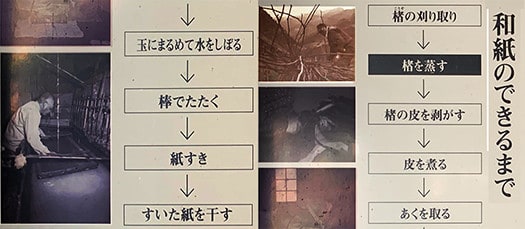



わたしたち現代人はあらゆるモノが近代的大量生産で作られる社会にいる。
資本主義的に原材料からその集散、生産過程の合理化、
出荷体制の整理と、流通過程のプロセスなどすべてが合理主義で貫徹し
激しい競争原理の中で需要と供給、価格がバランスしている社会。
こうした社会以前のモノの価値感、尺度というものを実感することは
ほとんどその機会がないと思う。
四国の人々の暮らしの歴史時間が凝縮している古民家空間では
そういった価値感の一端をうかがい知ることができる。
きのうまでみた伊予・愛媛の山間地域の河野家でも生業としての
「土佐紙」の生産過程、その原材料・コウゾの採集から加工生産までが
家内制手工業で生産されている様子が見られた。
現代の紙とはまったく価値観が違う「土佐紙」という商品経済が
この山深い四国でもながく息づいてきた様子を知ることができた。
紙というのは長く貴族社会、上流階級だけの独占に近く、
江戸期になってようやく教育の普及に伴って大衆化していった。
そのようななかで四国村野外博物館には「土佐のコウゾ蒸し小屋」がある。
もと高知県高岡郡檮原町に所在した土佐紙の原料、楮や三椏を蒸すための小屋。
内部に石で窯を築き蓋として釜にかぶせる大桶を上げ下げする装置をもつ。
寄棟造茅葺で外壁をも茅で葺いている点に特徴がある。
土佐は高級和紙の産地。この小屋では伝統の和紙づくりが行われていた。
切りそろえた楮やみつまたを束にして釜に立て、上から桶をかぶせて蒸す。
取り出して皮を剥ぎ、黒皮を取り、水に浸した白皮をモチにして棒でたたく。
最後に水に入れてすくい上げ紙に漉く・・・和紙作りは手のかかる作業だった。


それこそ貴族政治の時代から連綿として続いてきた地場産業。
奈良、平安時代から文書記録の最重要物資として土佐紙があり、
その生産がこの地域で営まれてきたというはるかさに、
北海道からの旅人としてはまことに強いインパクトを受ける。
そしてその産業基盤としての建築が残されていて、さらに生業として
民家での暮らしにながく根がらみしてきている様子を知ることで
その重さが伝わってくる思いがする。
現代の家づくりでよく「自然環境との調和」というフレーズが使われる。
それは主として「見える部分」での感覚の問題と捉えられているけれど、
こういうふうに生活丸ごとのありようとしての実態証言をみると
底の浅さを思い知らされるように感じられる。
このような環境、生業で先人は命を繋いできていた。
出版という紙を大量消費する人間として、初めてこういう歴史時間に触れました。
English version⬇
[Regional industry "Tosa paper" Kozo steamed hut Shikoku living space exploration-12]
We modern people are in a society where all things are made by modern mass production.
Capitalist from raw materials to their collection and distribution, rationalization of production process,
Arrangement of the shipping system and the process of the distribution process are all rationalistic.
A society in which supply and demand are balanced in a fierce competition principle.
To realize the value and scale of things before society
I think I rarely have that opportunity.
In the old folk house space where the historical time of the lives of the people of Shikoku is condensed
You can get a glimpse of such a sense of value.
Even the Kono family in the mountainous area of Iyo and Ehime, which I saw until yesterday, also worked as a livelihood.
The production process of "Tosa Paper", from the collection of its raw materials and mulberry to processing production
It was seen that it was produced by the cottage industry.
A commodity economy called "Tosa Paper" that has completely different values from modern paper
I was able to see how it has been breathing for a long time even in this mountainous Shikoku.
Paper has long been a noble society, close to the monopoly of the upper class,
Only in the Edo period became popular with the spread of education.
Under such circumstances, the Shikoku Village Open-Air Museum has a "Tosa Kozo Steamed Hut".
It was originally located in Ochi, Yusuhara Town, Takaoka District, Kochi Prefecture. A hut for steaming mulberry and mitsumata, the raw material for Tosa paper.
It has a device that builds a kiln with stones inside and raises and lowers a large tub that covers the pot as a lid.
It is characterized by the fact that the outer wall is also thatched with a hipped roof.
Tosa is a production center of high-quality Japanese paper. Traditional Japanese paper was made in this hut.
Put the chopped mulberry and mitsumata in a bundle and put them in a kettle, cover them with a tub from above, and steam them.
Take it out, peel it off, remove the black skin, and use the white skin soaked in water as a mochi and hit it with a stick.
Finally, put it in water and scoop it up and make it into paper ... Making Japanese paper was a laborious task.
That is the local industry that has continued since the era of aristocracy.
Since the Heian period in Nara, Tosa paper has been the most important material for document recording.
To the extent that its production has been carried out in this area,
As a traveler from Hokkaido, it has a really strong impact.
And the architecture as the industrial base is left, and as a living business
By knowing how the roots of living in a private house are becoming more and more entrenched
I feel that the weight is transmitted.
The phrase "harmony with the natural environment" is often used in modern home building.
It's mainly seen as a sensory problem in the "visible part",
Looking at the actual testimony of the whole life like this
It feels like you are reminded of the shallowness of the bottom.
In such an environment and livelihood, our ancestors have been able to save their lives.
For the first time as a person who consumes a large amount of paper called publishing, I came into contact with this kind of historical time.



















